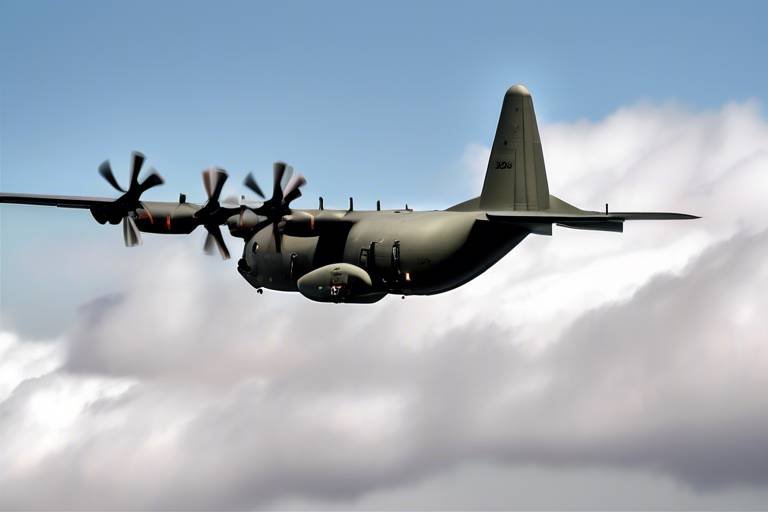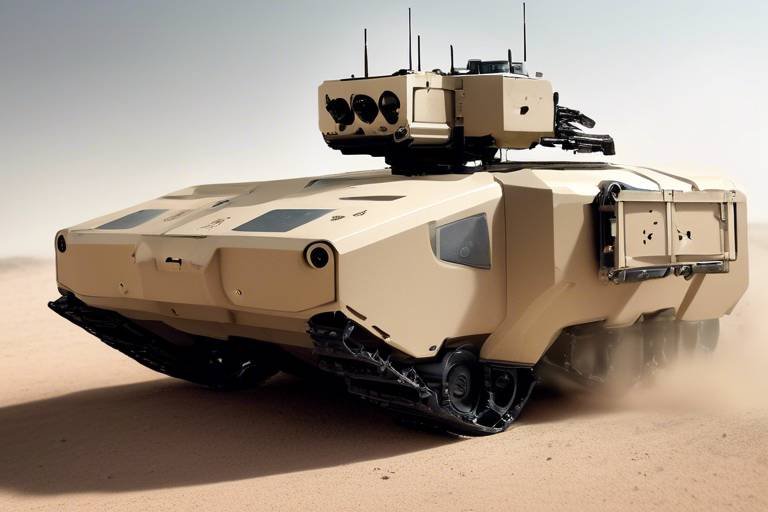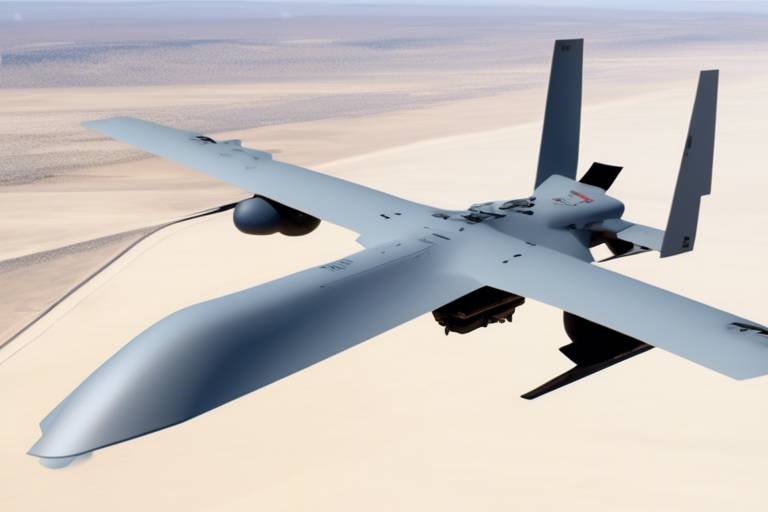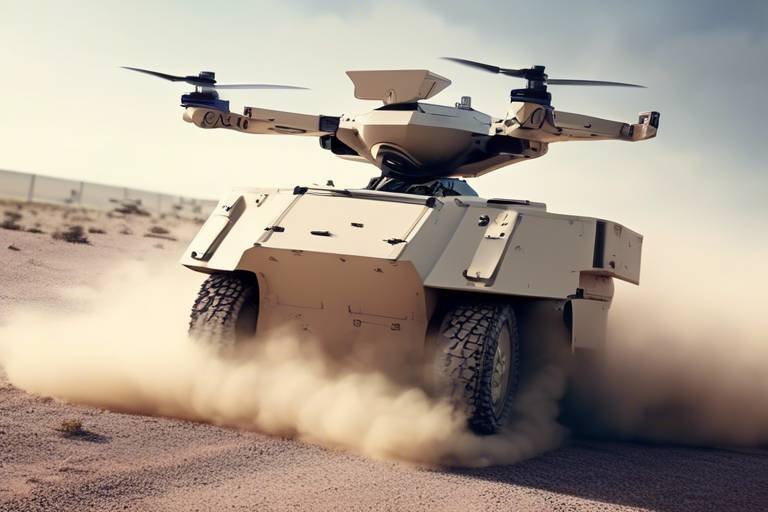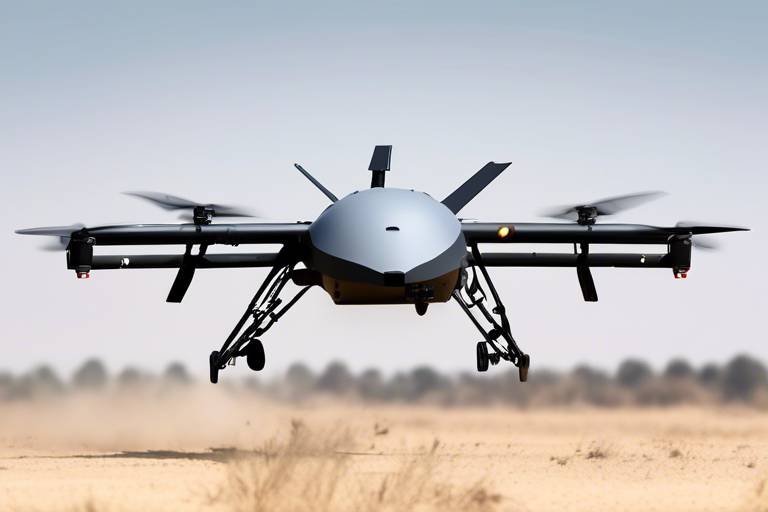The Effectiveness of the Robotic Load Carrier in Resupply Missions
In today's fast-paced world, the demand for efficient logistics and resupply operations has never been higher. Enter the robotic load carrier—a game-changer in the realm of transportation and supply chain management. These automated systems are not just a fancy piece of technology; they represent a significant leap forward in how we think about moving goods from point A to point B. Imagine a world where deliveries are made without the need for human intervention, where efficiency reigns supreme, and where safety is prioritized. That's the promise of robotic load carriers, and it's time we delve into the specifics of their effectiveness in resupply missions.
Robotic load carriers are designed with a singular purpose: to transport goods efficiently and reliably. Their design incorporates advanced sensors, navigation systems, and artificial intelligence, allowing them to operate autonomously in various environments. From warehouses to battlefields, these robots are engineered to handle the challenges of logistics with precision. The technological advancements that have propelled their development are nothing short of remarkable. With improvements in battery life, navigation technology, and cargo handling capabilities, robotic load carriers are becoming increasingly indispensable in resupply missions.
The advantages of using robotic load carriers in resupply operations are numerous and compelling. First and foremost, these machines significantly enhance operational efficiency. Unlike human workers, robotic load carriers can operate around the clock without the need for breaks or rest periods. This continuous operation leads to a remarkable increase in the speed of resupply missions. For instance, consider a military operation where timely delivery of supplies can mean the difference between success and failure. Robotic load carriers can ensure that vital resources reach their destination swiftly, thereby improving mission outcomes.
When it comes to efficiency, robotic load carriers are in a league of their own. They can navigate complex environments and transport heavy loads without succumbing to fatigue. In various case studies, these robotic systems have demonstrated their ability to complete resupply missions in a fraction of the time it would take human workers. For example, in a recent logistics operation, a fleet of robotic load carriers managed to deliver essential supplies to remote locations in record time, showcasing their potential to revolutionize the way we think about supply chains.
Time is of the essence in any resupply mission. By automating transportation tasks, robotic load carriers drastically reduce the time needed for resupply operations. Imagine a scenario where a team is racing against the clock to deliver medical supplies to a disaster-stricken area. With robotic load carriers, the delivery process can be streamlined, ensuring that help arrives when it's needed most. This time-saving capability not only enhances mission success but also allows for better allocation of human resources to other critical tasks.
Another significant benefit of robotic load carriers is their ability to optimize resources. These machines minimize human error, which is often a costly factor in logistical operations. By maximizing cargo capacity and ensuring precise handling of goods, robotic load carriers lead to substantial cost savings. For example, in a warehouse setting, the integration of robotic load carriers has been shown to reduce operational costs by up to 30%, proving that investing in automation can yield significant financial returns.
Safety is paramount in any operational environment, especially in hazardous conditions. Robotic load carriers contribute to safer operations by minimizing human exposure to dangerous terrains and situations. For instance, in military resupply missions, sending a robot to deliver supplies to a frontline position can significantly reduce the risk to personnel. These machines can traverse rough terrains, navigate through obstacles, and even operate in adverse weather conditions, all while ensuring that the supplies reach their destination intact. The peace of mind that comes with knowing that humans are kept out of harm's way is invaluable.
Despite the myriad advantages, the implementation of robotic load carriers is not without its challenges. One of the primary obstacles is the technological limitations that currently exist. While advancements in AI and robotics are impressive, there are still gaps that need to be addressed to meet the complex demands of all resupply missions. Moreover, integrating these robotic systems into existing logistical frameworks can pose significant hurdles. Organizations must carefully consider how to incorporate these technologies without disrupting their current operations.
Current technology may not fully support the intricate demands of every resupply mission. For example, while some robotic load carriers excel in structured environments like warehouses, they may struggle in unpredictable outdoor settings. Addressing these technological gaps is essential for the broader adoption of robotic load carriers in various sectors.
Integrating robotic load carriers into existing logistical frameworks can be a daunting task. Organizations must navigate potential hurdles such as compatibility with current systems and training personnel to work alongside these machines. However, with careful planning and execution, seamless integration is achievable and can lead to enhanced operational capabilities.
The future of robotic load carriers in resupply missions is bright, with ongoing advancements in AI and automation. As technology continues to evolve, we can expect to see even more sophisticated robotic systems that can handle a wider range of tasks. Innovations such as improved navigation systems, enhanced AI capabilities, and better battery technology will likely shape the future landscape of logistics. The potential for these machines to transform supply chains is immense, and as we move forward, their role will only become more significant.
- What are robotic load carriers? Robotic load carriers are automated systems designed to transport goods efficiently in various environments.
- How do robotic load carriers improve efficiency? They operate continuously without fatigue, significantly increasing the speed of resupply missions.
- What challenges do robotic load carriers face? Challenges include technological limitations and integration issues with existing logistics systems.
- What is the future of robotic load carriers? The future looks promising with advancements in AI and automation, leading to more sophisticated systems.

Introduction to Robotic Load Carriers
Robotic load carriers are revolutionizing the way we think about logistics and resupply missions. Imagine a world where goods are transported without the need for human intervention, where efficiency and precision reign supreme. These automated systems are designed not just to move items from point A to point B, but to do so in a manner that is both efficient and reliable. They represent a significant leap forward in technology, combining advanced robotics, artificial intelligence, and cutting-edge navigation systems.
The design of robotic load carriers varies widely, tailored to meet the specific demands of different environments. From warehouses to battlefields, these machines are equipped with sensors, cameras, and sophisticated software that allow them to navigate complex terrains and avoid obstacles. This adaptability is a game-changer; it means that no matter the setting—be it an urban landscape or a rugged outdoor area—robotic load carriers can operate effectively. The increased use of these systems in resupply missions can be attributed to several technological advancements:
- Improved Navigation: Enhanced GPS and mapping technologies enable precise routing.
- Autonomous Operation: AI algorithms allow for decision-making without human input.
- Load Capacity: Innovations in design have led to carriers that can handle larger and heavier loads.
As these technologies continue to evolve, the potential applications for robotic load carriers expand exponentially. In military contexts, they can deliver supplies to troops in the field, reducing the risk to human life. In commercial settings, they streamline operations, allowing businesses to reduce costs and improve service delivery. The efficiency gained through automation can be likened to having a supercharged delivery system that never tires and always operates at peak performance.
In summary, the introduction of robotic load carriers marks a significant milestone in logistics and transportation. Their ability to operate autonomously in various environments not only enhances operational efficiency but also opens up new possibilities for resupply missions. As we delve deeper into the advantages they offer, it becomes clear that these machines are more than just tools; they are integral components of the future of logistics.
- What are robotic load carriers? Robotic load carriers are automated systems designed to transport goods efficiently, often without human intervention.
- How do they improve efficiency? They can operate continuously without fatigue, significantly speeding up resupply missions.
- What challenges do they face? Technological limitations and integration with existing systems are primary challenges to their widespread adoption.
- What is the future of robotic load carriers? With ongoing advancements in AI and automation, their future looks promising in logistics and resupply operations.

Advantages of Using Robotic Load Carriers
Robotic load carriers are revolutionizing the way we think about logistics and resupply missions. Imagine a world where goods can be transported without the constraints of human fatigue or error. That's the reality these innovative machines are creating. With their ability to operate around the clock, they not only boost efficiency but also significantly reduce costs associated with labor and transportation. In this section, we will delve into the myriad benefits these robotic systems bring to the table, showing how they can transform logistical operations across various sectors.
One of the most compelling advantages of robotic load carriers is their increased efficiency. These machines are designed to handle heavy loads and navigate complex environments without the need for breaks. For instance, in a recent case study involving a military resupply mission, robotic load carriers were able to deliver supplies to remote locations in half the time it would take a human team. This not only speeds up the entire operation but also ensures that resources are utilized more effectively. The ability to operate continuously means that logistical chains can be streamlined, leading to faster turnaround times and improved service delivery.
Moreover, the time savings associated with robotic load carriers have a ripple effect on mission success. When transportation tasks are automated, the overall duration of missions is significantly reduced. For example, during a humanitarian aid operation, the deployment of robotic load carriers allowed teams to focus on critical tasks rather than spending hours transporting supplies manually. This is a game-changer, as it allows organizations to respond more quickly to emergencies, ultimately saving lives.
Another critical aspect to consider is resource optimization. Robotic load carriers are not just about speed; they also enhance the accuracy of operations. By minimizing human error—such as miscalculating load weights or misrouting deliveries—these machines ensure that resources are allocated more effectively. This optimization can lead to substantial cost savings for organizations, as they can transport more goods in a single trip, reducing the need for multiple journeys. A table summarizing the cost benefits of using robotic load carriers versus traditional methods could further illustrate this point:
| Aspect | Traditional Methods | Robotic Load Carriers |
|---|---|---|
| Operational Hours | 8-10 hours/day | 24/7 operation |
| Labor Costs | High | Reduced |
| Error Rate | Higher | Minimal |
| Load Capacity | Limited | Maximized |
Additionally, the enhanced safety that comes with using robotic load carriers cannot be overstated. In environments where human workers might be exposed to hazardous conditions—like combat zones or disaster-stricken areas—these machines can take over the transportation of supplies, minimizing the risk to human life. This not only protects personnel but also ensures that critical supplies reach their destinations without delay. The integration of advanced sensors and AI technology enables these robots to navigate challenging terrains, making them invaluable in various operational contexts.
In summary, the advantages of using robotic load carriers are clear. They offer increased efficiency, significant time savings, optimized resource management, and enhanced safety. As we continue to explore the potential of these machines, it’s evident that they are not just a passing trend but a fundamental shift in how we approach logistics and resupply missions.
- What are robotic load carriers?
Robotic load carriers are automated systems designed to transport goods efficiently, often used in logistics and resupply missions. - How do robotic load carriers improve efficiency?
They can operate continuously without fatigue, significantly speeding up resupply operations. - Are robotic load carriers safe to use?
Yes, they minimize human exposure to hazardous environments, enhancing overall safety in operations. - What challenges do robotic load carriers face?
They encounter technological limitations and integration issues with existing logistical systems. - What is the future of robotic load carriers?
With ongoing advancements in AI and automation, their use in logistics is expected to grow and evolve.

Increased Efficiency
When it comes to resupply missions, efficiency is the name of the game. Robotic load carriers are revolutionizing the way goods are transported by offering a level of operational efficiency that traditional methods simply can't match. Imagine a world where supply chains are streamlined, delays are minimized, and resources are utilized to their fullest potential. That's the reality that robotic load carriers are bringing to the table.
One of the most striking features of these automated systems is their ability to operate continuously, without the fatigue that human workers experience. This means they can work around the clock, ensuring that resupply missions are executed swiftly and effectively. For instance, in a recent case study conducted in a remote military base, robotic load carriers were able to deliver essential supplies to troops in half the time it would have taken human-operated vehicles. This not only saved time but also ensured that critical supplies reached their destination when they were needed most.
But what does this increased efficiency really look like in practice? Here are some key aspects:
- 24/7 Operation: Robotic load carriers can function day and night, making them ideal for urgent resupply missions.
- Reduced Transit Times: With advanced navigation systems, these carriers can find the quickest routes, avoiding traffic and obstacles.
- Consistent Performance: Unlike human workers, robotic systems do not suffer from fatigue, ensuring a steady output throughout the mission.
In terms of time savings, the impact is tangible. By automating transportation tasks, robotic load carriers can significantly cut down the time needed for resupply missions. Consider a scenario where a delivery typically takes 10 hours. With robotic load carriers, this could be reduced to just 6 hours. That’s a 40% improvement! Such enhancements can dramatically affect overall mission success, allowing teams to focus on critical tasks rather than logistics.
Moreover, the resource optimization afforded by robotic load carriers is another game-changer. By minimizing human error and maximizing cargo capacity, these systems allow for better allocation of resources. For example, in a logistics operation where human drivers may miscalculate weight limits or cargo space, robotic systems are programmed to optimize loads efficiently, leading to cost savings. According to industry reports, companies that have integrated robotic load carriers into their supply chains have seen a reduction in operational costs by up to 30%.
In summary, the increased efficiency brought about by robotic load carriers is not just a minor enhancement; it’s a fundamental shift in how resupply missions are conducted. With their ability to operate continuously, reduce transit times, and optimize resource allocation, these automated systems are paving the way for a future where logistics are faster, safer, and more cost-effective.
- What are robotic load carriers?
Robotic load carriers are automated systems designed to transport goods efficiently, often used in logistics and supply chain operations. - How do robotic load carriers improve efficiency?
They operate continuously, reduce transit times, and optimize resource allocation, which leads to faster and more cost-effective resupply missions. - Can robotic load carriers work in challenging environments?
Yes, many robotic load carriers are designed to navigate complex terrains and can be equipped with advanced sensors to handle various challenges.

Time Savings
When it comes to resupply missions, every second counts. Imagine a scenario where a military unit is stationed in a remote area, and they need essential supplies to continue their operations. In such situations, can be the difference between mission success and failure. Robotic load carriers (RLCs) have revolutionized the way goods are transported, allowing for faster and more efficient resupply operations. These automated systems can operate around the clock, tirelessly transporting supplies without the need for breaks or rest, which is a game changer in high-pressure environments.
One of the standout features of RLCs is their ability to navigate complex terrains seamlessly. They are equipped with advanced sensors and AI algorithms that enable them to adapt to various conditions, whether it’s rocky landscapes or urban environments. This adaptability means that they can take the most efficient routes, significantly reducing the time it takes to deliver supplies. Consider a traditional method where human operators must navigate these terrains manually; it’s not only time-consuming but also fraught with potential delays due to fatigue or unforeseen obstacles. In contrast, RLCs can consistently deliver supplies in a fraction of the time.
To illustrate the impact of time savings, let’s take a look at a case study involving a military operation in a mountainous region. In this scenario, the use of robotic load carriers reduced resupply time by over 50%. Here’s a quick breakdown of the time savings:
| Method | Time Taken (Hours) |
|---|---|
| Traditional Human Transport | 12 |
| Robotic Load Carriers | 5 |
As you can see from the table, the robotic load carriers not only sped up the process but also ensured that supplies reached the troops quickly, allowing them to maintain their operational readiness. This is particularly crucial in military contexts, where delays can have serious consequences.
Moreover, the time savings provided by RLCs extend beyond just the immediate delivery of goods. With faster resupply missions, teams can focus on their core tasks without the constant worry of running low on supplies. This shift in focus can lead to improved morale and overall mission effectiveness. In essence, robotic load carriers are not just about moving goods; they’re about enhancing the entire operational workflow.
In conclusion, the time savings offered by robotic load carriers in resupply missions are profound. By automating transport tasks, these systems not only speed up delivery but also contribute to a more efficient and effective logistical operation. As technology continues to advance, we can expect these time savings to become even more significant, further solidifying the role of RLCs in modern logistics.
- What are robotic load carriers?
Robotic load carriers are automated systems designed to transport goods efficiently, often used in resupply missions across various environments. - How do robotic load carriers save time?
They operate continuously without fatigue, navigate complex terrains using advanced sensors, and can significantly reduce the time needed for resupply missions. - Are there any challenges in implementing robotic load carriers?
Yes, challenges include technological limitations and integration issues with existing logistical frameworks. - What is the future of robotic load carriers?
The future looks promising with ongoing advancements in AI and automation, which could enhance their capabilities and integration into logistics.

Resource Optimization
When it comes to resupply missions, is a game-changer, and robotic load carriers are at the forefront of this revolution. Imagine a world where every ounce of cargo is utilized to its fullest potential, reducing waste and maximizing efficiency. Robotic load carriers excel in this domain by minimizing human error and enhancing cargo capacity. These automated systems are designed to calculate the best routes, manage loads, and adjust to real-time conditions, ensuring that resources are allocated effectively.
One of the standout features of robotic load carriers is their ability to operate under various conditions without the fatigue that human operators might experience. This means they can work longer hours, transporting goods consistently and reliably. For instance, in a military resupply operation, a robotic load carrier can deliver supplies to the front lines without the risk of human error that might occur during manual handling. This reduces the chances of miscalculating loads or forgetting essential items, which can be critical in high-stakes environments.
Furthermore, these robotic systems can be equipped with advanced sensors and AI algorithms that analyze the weight and volume of the cargo, optimizing each trip for maximum efficiency. This capability allows them to adjust their loads dynamically, ensuring that they are not overburdened or underutilized. In essence, they act like a well-oiled machine, constantly fine-tuning their operations to achieve the best outcomes.
To illustrate the impact of resource optimization through robotic load carriers, consider the following table that compares traditional resupply methods with robotic systems:
| Aspect | Traditional Resupply | Robotic Load Carriers |
|---|---|---|
| Human Error | Higher risk of mistakes | Minimized through automation |
| Operational Hours | Limited by human shifts | Can operate continuously |
| Cargo Capacity | Often underutilized | Optimized for maximum load |
| Cost Efficiency | Higher due to labor and errors | Lower operational costs |
As we can see, the advantages of using robotic load carriers for resource optimization are clear and compelling. By leveraging technology, these systems not only reduce costs but also enhance the effectiveness of logistical operations. They allow organizations to do more with less, ensuring that every resource is utilized to its fullest potential. In a world where efficiency is paramount, robotic load carriers stand out as a vital asset in modern resupply missions.
- What are robotic load carriers?
Robotic load carriers are automated systems designed to transport goods efficiently, reducing the need for human labor in logistical operations. - How do robotic load carriers improve efficiency?
They operate continuously without fatigue, optimize routes, and manage loads effectively, leading to faster resupply missions. - What challenges do robotic load carriers face?
They encounter technological limitations and integration issues with existing systems, which can hinder widespread adoption. - What is the future of robotic load carriers?
With advancements in AI and automation, the future looks bright for robotic load carriers, promising even greater efficiency and integration in logistics.

Enhanced Safety
When it comes to resupply missions, safety is paramount. Robotic load carriers (RLCs) are revolutionizing the way we think about operational safety in challenging environments. These innovative machines are designed to minimize human exposure to hazards, which is particularly crucial in unpredictable terrains. Imagine navigating through a war zone or a disaster-stricken area; the risks are immense. By deploying RLCs, we can significantly reduce the number of personnel in harm's way.
One of the most compelling aspects of robotic load carriers is their ability to operate in environments that may be too dangerous for humans. For instance, in military operations, these machines can transport supplies across minefields or through areas with potential threats. This not only protects human lives but also ensures that critical supplies reach their destinations on time. The contrast is stark: while a human operator might hesitate or be unable to proceed in a risky situation, an RLC can be programmed to navigate obstacles and complete its mission without fear.
Moreover, RLCs are equipped with advanced sensors and AI technology that enhance their situational awareness. They can detect obstacles, assess environmental conditions, and make real-time decisions to avoid accidents. For example, if a robotic load carrier encounters an unexpected obstacle, it can quickly reroute itself, ensuring that it maintains a safe path without requiring human intervention. This level of responsiveness is crucial in maintaining operational safety.
Another significant safety feature of robotic load carriers is their ability to monitor and report on environmental conditions. Equipped with sensors that can measure temperature, humidity, or even detect hazardous materials, these machines can provide valuable data that helps in assessing risks. This capability allows decision-makers to take proactive measures, ensuring that both the supplies and the personnel involved in the mission are safeguarded.
In terms of operational efficiency, the safety benefits of RLCs translate into fewer accidents and incidents, which can be costly both in human terms and financially. Consider the following:
- Reduced medical costs associated with injuries.
- Lower insurance premiums due to fewer reported incidents.
- Increased morale among personnel who feel safer in their operational environment.
In conclusion, the integration of robotic load carriers into resupply missions enhances safety in multiple ways. By minimizing human exposure to dangerous situations, providing real-time data, and ensuring precise navigation, RLCs are not just a technological advancement; they are a game-changer in how we approach safety in logistics. As we continue to refine and develop these systems, we can expect even greater improvements in operational safety, making missions not only more efficient but also significantly safer.
- What are robotic load carriers?
Robotic load carriers are automated systems designed to transport goods efficiently, often used in resupply missions to enhance operational effectiveness. - How do robotic load carriers improve safety?
They minimize human exposure to hazardous environments, utilize advanced sensors for navigation, and can monitor environmental conditions to ensure safe operations. - Can robotic load carriers operate in all types of terrains?
While they are designed for a variety of environments, their effectiveness can depend on the technology used and the specific challenges of the terrain. - What are the future prospects for robotic load carriers?
With ongoing advancements in AI and automation, the future looks promising for RLCs, with potential innovations that could further enhance their capabilities in logistics.

Challenges in Implementing Robotic Load Carriers
While robotic load carriers (RLCs) are revolutionizing the way we approach resupply missions, their implementation is not without its challenges. One of the primary hurdles is the technological limitations that currently exist. Although advancements in robotics and automation have made significant strides, many RLCs still struggle to navigate complex environments effectively. For instance, they may face difficulties in recognizing obstacles or adapting to sudden changes in terrain, which can lead to delays or operational failures. This limitation can be particularly detrimental in critical missions where time and accuracy are of the essence.
Furthermore, integration with existing logistical systems poses another significant challenge. Many organizations have established frameworks and processes that are deeply rooted in traditional methods of operation. Introducing robotic load carriers into these systems requires careful planning and coordination. It’s not just about deploying the technology; it’s about ensuring that it works harmoniously with human operators and other machinery. Organizations must invest time and resources into training personnel and developing protocols that facilitate this integration.
Moreover, the cost of implementing robotic load carriers can be a barrier for many companies. While the long-term savings from reduced labor costs and increased efficiency are appealing, the initial investment in RLC technology can be substantial. For smaller businesses or those operating on tight budgets, this upfront cost can deter them from adopting these innovative solutions. It's essential for stakeholders to weigh the return on investment against the potential benefits to determine if RLCs are a viable option for their operations.
Another critical aspect to consider is the regulatory landscape. As robotic technology evolves, so too does the need for regulations that govern their use. Compliance with local laws and regulations can be a complex process, often requiring extensive documentation and approval. Companies must navigate these legal waters carefully to avoid potential fines or operational shutdowns. This bureaucratic aspect can slow down the adoption of robotic load carriers, as organizations may hesitate to invest in technology that could face regulatory scrutiny.
Finally, there are the human factors to consider. Resistance to change is a natural human response, and many employees may feel threatened by the introduction of robotic systems. Concerns about job security and the need for retraining can create a challenging atmosphere within the workplace. Addressing these concerns through transparent communication and training programs is vital for fostering a culture that embraces innovation rather than fears it.
In summary, while robotic load carriers present exciting opportunities for enhancing resupply missions, the path to their successful implementation is fraught with challenges. From technological limitations and integration issues to cost concerns and regulatory hurdles, organizations must carefully navigate these obstacles to fully realize the potential of RLCs in their operations. By addressing these challenges head-on, companies can pave the way for a future where robotic load carriers play a pivotal role in logistics.
- What are robotic load carriers?
Robotic load carriers are automated systems designed to transport goods efficiently, often used in logistics and resupply missions. - What challenges do companies face when implementing RLCs?
Challenges include technological limitations, integration with existing systems, high initial costs, regulatory compliance, and human resistance to change. - How can organizations overcome resistance to robotic systems?
Organizations should focus on transparent communication and provide training programs to help employees adapt to new technologies. - Are robotic load carriers cost-effective?
While the initial investment can be high, RLCs can lead to long-term savings through increased efficiency and reduced labor costs.

Technological Limitations
While robotic load carriers (RLCs) are revolutionizing the way we approach resupply missions, they are not without their . One of the most significant challenges lies in the complexity of navigation. Many RLCs rely on GPS for location tracking, which can be unreliable in environments with poor satellite visibility, such as dense urban areas or rugged terrains. This can lead to navigational errors, making it difficult for these machines to reach their intended destinations efficiently.
Moreover, the ability to adapt to changing environments is another hurdle. RLCs often struggle with unpredicted obstacles, such as construction sites, fallen debris, or even animals crossing their paths. Their sensors might not be advanced enough to recognize and react to these new challenges quickly, resulting in potential delays or even accidents. To illustrate this point, consider the following table that outlines some common technological limitations faced by robotic load carriers:
| Limitation | Description |
|---|---|
| GPS Dependency | RLCs often rely on GPS for navigation, which can be unreliable in certain environments. |
| Obstacle Detection | Limited ability to detect and adapt to dynamic obstacles in real-time. |
| Battery Life | RLCs have limited operational time due to battery constraints, affecting long missions. |
| Data Processing | Current systems may struggle with processing large amounts of data quickly enough for real-time decision-making. |
Another critical issue is the battery life of these machines. Most RLCs are powered by rechargeable batteries that have a limited lifespan, which means they require frequent recharging or battery swaps during long missions. This can lead to downtime, reducing overall efficiency. Picture a scenario where a robotic carrier is halfway through delivering supplies, only to halt because of a drained battery. The time lost during this period can be crucial, especially in emergency resupply situations.
Furthermore, data processing capabilities are essential for RLCs to operate effectively. As they gather data from their surroundings, they need to analyze this information quickly to make decisions in real-time. However, many current systems are not equipped to handle large volumes of data efficiently, which can result in delays in response times. It’s akin to trying to read a book while simultaneously watching a movie; the brain can only process so much information at once.
In conclusion, while robotic load carriers hold immense potential for enhancing resupply missions, addressing these is vital for their success. The industry must invest in research and development to create more sophisticated navigation systems, improve obstacle detection capabilities, extend battery life, and enhance data processing speeds. Only then can we fully harness the power of robotic load carriers in logistics.
- What are robotic load carriers? Robotic load carriers are automated systems designed to transport goods efficiently in various environments.
- What are the main advantages of using robotic load carriers? They offer improved efficiency, reduced labor costs, and enhanced safety, making logistical operations more effective.
- What challenges do robotic load carriers face? They encounter technological limitations such as GPS dependency, obstacle detection issues, battery life constraints, and data processing challenges.
- How can the future of robotic load carriers be improved? By investing in advanced technology, enhancing navigation systems, and improving battery and data processing capabilities.

Integration with Existing Systems
Integrating robotic load carriers into existing logistical frameworks presents a unique set of challenges that organizations must navigate carefully. As industries increasingly adopt automation, the need for these robotic systems to work seamlessly with traditional supply chain operations becomes paramount. This integration isn't just about plugging in new technology; it requires a comprehensive understanding of both the new systems and the legacy processes in place.
One of the primary hurdles in integration is the compatibility of software systems. Many organizations rely on established logistics management software, which may not be designed to communicate with robotic systems. To address this, companies often need to invest in middleware solutions or custom software development to create a bridge between the two. This can be time-consuming and costly, but the payoff can be substantial in terms of operational efficiency.
Another significant factor is the training of personnel. Employees accustomed to traditional methods may need extensive training to effectively operate and manage robotic load carriers. It’s not just about understanding how to use the new technology; staff must also learn how to troubleshoot issues and optimize the performance of these systems. This transition can be daunting, but with the right training programs, organizations can foster a culture of innovation and adaptability.
Moreover, physical infrastructure may also require adjustments to accommodate robotic systems. For instance, loading docks, pathways, and storage areas may need to be redesigned to facilitate the movement of robotic carriers. This can involve significant investment but is essential for maximizing the efficiency of the robotic systems. Below is a table summarizing some of the critical aspects to consider during integration:
| Integration Aspect | Considerations |
|---|---|
| Software Compatibility | Ensure existing logistics software can communicate with robotic systems; consider middleware solutions. |
| Personnel Training | Invest in comprehensive training programs to prepare staff for new technology. |
| Infrastructure Modifications | Assess and redesign physical spaces to accommodate robotic load carriers. |
Ultimately, the successful integration of robotic load carriers hinges on a strategic approach that encompasses technology, people, and processes. Organizations that invest the time and resources into addressing these challenges are likely to reap the rewards of enhanced efficiency and reduced operational costs.
- What are robotic load carriers?
Robotic load carriers are automated systems designed to transport goods efficiently within various environments, including warehouses, factories, and outdoor settings.
- How do robotic load carriers improve efficiency?
They can operate continuously without fatigue, significantly speeding up resupply missions and reducing the time needed for logistics operations.
- What challenges do companies face when integrating robotic load carriers?
Challenges include software compatibility, the need for personnel training, and potential modifications to physical infrastructure.
- What is the future of robotic load carriers?
The future looks promising, with advancements in AI and automation likely to enhance their capabilities and integration into logistics.

The Future of Robotic Load Carriers in Resupply Missions
As we gaze into the horizon of technological advancements, the future of robotic load carriers in resupply missions appears to be not just bright but also transformative. Imagine a world where these automated systems operate seamlessly alongside humans, enhancing efficiency and safety in logistics operations. With the rapid evolution of artificial intelligence (AI) and automation technologies, the capabilities of robotic load carriers are expected to expand significantly. This section delves into the promising trends and innovations that could redefine the landscape of resupply missions.
One of the most exciting aspects of the future is the integration of AI-driven decision-making processes. These advanced algorithms will enable robotic load carriers to analyze vast amounts of data in real-time, allowing them to adapt to changing environments and optimize their routes. For instance, think of a robotic carrier navigating through a complex warehouse. With AI, it could learn the most efficient paths, avoid obstacles, and even predict the best times for resupply based on historical data. This level of adaptability will not only enhance efficiency but also minimize delays and disruptions in the supply chain.
Moreover, the incorporation of machine learning will allow these carriers to improve their performance over time. Just like a student who learns from past mistakes, robotic load carriers will refine their operations based on previous missions. They will identify patterns, understand peak demand times, and even adjust their cargo loads accordingly. This leads to a more intelligent and responsive logistics system that can handle the complexities of modern supply chains.
Additionally, the future of robotic load carriers will likely see them becoming more autonomous. With advancements in sensor technology and navigation systems, these carriers will be able to operate independently in various environments, from bustling warehouses to challenging outdoor terrains. The ability to function without human intervention not only boosts efficiency but also reduces the risks associated with human error. Imagine a scenario where a robotic load carrier can deliver supplies to remote locations without needing constant oversight. This autonomy will be a game-changer in logistics operations.
Furthermore, as we look ahead, the potential for collaboration between humans and robots is immense. Rather than replacing human workers, robotic load carriers will complement their efforts. Picture a scenario in a military resupply mission where soldiers and robotic carriers work side by side. While the robots handle the heavy lifting and transportation, soldiers can focus on strategic planning and execution. This synergy will enhance operational effectiveness and safety, especially in high-risk environments.
However, with these advancements come challenges. The need for robust cybersecurity measures will become increasingly critical. As robotic load carriers become more interconnected and reliant on data, the potential for cyber threats grows. Ensuring the safety and integrity of these systems will be paramount to their successful deployment in resupply missions.
In conclusion, the future of robotic load carriers in resupply missions is poised for revolutionary changes. With ongoing innovations in AI, machine learning, and autonomous navigation, these systems will not only enhance efficiency and safety but also redefine how logistics operations are conducted. As we embrace these advancements, it's crucial to keep an eye on the challenges ahead and work towards solutions that ensure the safe and effective use of these remarkable technologies.
- What are robotic load carriers?
Robotic load carriers are automated systems designed to transport goods efficiently, often used in logistics and resupply operations.
- How do robotic load carriers improve efficiency?
They can operate continuously without fatigue, optimize routes using AI, and minimize human error, leading to faster and more reliable resupply missions.
- What challenges do robotic load carriers face?
Challenges include technological limitations, integration with existing systems, and the need for robust cybersecurity measures to protect against threats.
- What is the role of AI in the future of robotic load carriers?
AI will enable these carriers to make real-time decisions, learn from past missions, and adapt to changing environments, enhancing their overall performance.
Frequently Asked Questions
- What are robotic load carriers?
Robotic load carriers are automated systems designed to transport goods efficiently, often used in resupply missions to enhance logistics and operational effectiveness.
- How do robotic load carriers improve efficiency in resupply missions?
These carriers can operate continuously without fatigue, allowing for faster transportation of goods. This leads to significant time savings and better resource allocation during missions.
- What are the safety benefits of using robotic load carriers?
Robotic load carriers minimize human exposure to hazardous environments, which enhances safety for personnel working in challenging terrains or during high-risk operations.
- What challenges do robotic load carriers face in implementation?
Some challenges include technological limitations that may not meet all mission requirements and difficulties in integrating these systems with existing logistical frameworks.
- How can technological advancements impact the future of robotic load carriers?
Ongoing advancements in AI and automation are expected to enhance the capabilities of robotic load carriers, making them more efficient and adaptable for various resupply missions.
- Are there specific case studies that demonstrate the effectiveness of robotic load carriers?
Yes, several case studies have shown that robotic load carriers significantly reduce the time and labor costs associated with resupply missions, proving their effectiveness in real-world applications.
- Can robotic load carriers operate in all types of environments?
While they are designed for versatility, their performance can be limited by current technology and environmental conditions, which may require further advancements to fully optimize their use.







